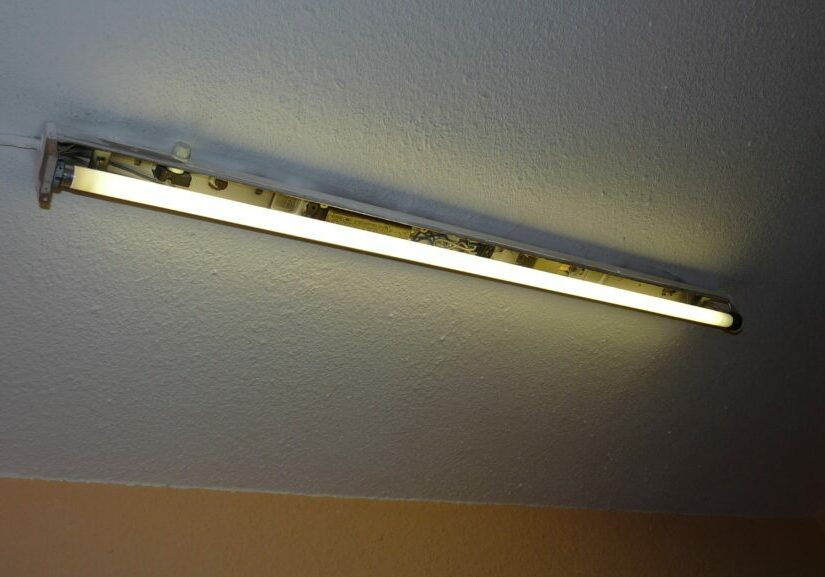When polychlorinated biphenyls (PCBs) leak from aging uorescent lighting ballasts, they expose staff and students to sig- nificant amounts of toxic and poten- tially carcinogenic chemicals. Chronic, long-term exposure to these manufactured chemicals is toxic to the liver and to the immune, reproductive, nervous, and endocrine systems. Fetal exposure to PCBs causes low birth weight, brain damage, and cognitive deficits.
In a 2010 pilot study in New York City schools, the U.S. Environmental Protection Agency (EPA) traced unexpectedly high air concentrations of PCBs to leaking ballasts. Testing in other schools confirmed these results. Then in December 2010 EPA released a guidance document for schools on managing the risks from these ballasts. (See “For More Information”). Local association involvement is needed to spur remedial action in school districts. Together with their UniServ field represen- tatives, they may find members willing to unite around this issue.
U.S. manufacture of PCBs was banned in 1977, but PCBs per- sist in the environment and the food chain. Typically only trace amounts are taken in by ingestion, inhalation and skin contact, but PCBs accumulate in the body potentially triggering disease.
Fluorescent lighting ballasts manufactured before 1979 most likely contain PCBs. These bal- lasts may still be functioning and releasing PCBs into the air. Well past their service life, they are subject to fires which release ad- ditional toxic chemicals. An oily PCB residue can ooze from the ballasts and be spread on the lighting fixture, oors, desks and books while continuing to off-gas PCBs.
Skin contact is a particular risk for maintenance and custodial staff even during routine assignments. Children in the lower grades are especially at risk due to their hand to mouth habits.
EPA guidance
The U.S. Environmental Protection Agency (EPA) has established safe reference air concentrations for PCBs; no safe level exists for pregnant women. Government agencies currently do not enforce these levels.
In a March letter to New Jersey Department of Education (NJDOE), NJEA urged a coordinated response by state agencies to assist districts in interpreting and implementing the new EPA guidance. NJEA requested that the department name a state coordinator and issue fact sheets on PCB health hazards in schools. Such steps, NJEA insisted, would aid districts in planning, prioritizing, and communicating appropriate remedial actions. As of press time, the department has not responded.
Prioritize remedial action
In pre-1980 construction, health and safety committees should review site-specific PCB operating and emergency management plans and monitor compliance. Committees should carefully examine any reports that claim no PCBs were found.
Although intact, functioning ballasts do not pose an immediate health threat, they will eventually fail. The EPA encourages a systematic program of identification, tracking, and phased replacement. Remedial management and phased replacement do not necessitate full building evacuation. However, special contractors should be employed to prevent the spread of contamination during the retrofit.
Delay has consequences. Replacement parts for older lighting systems are already being phased out, so long-term maintenance of ballasts containing PCBs is unrealistic. Maintenance can be hazardous. Decontamination is expensive.
Action has benefits. Energy gains from retrofits to newer lighting systems are economical within several years.
Local associations working with their UniServ field representatives must ensure that where PCB ballasts are present, the substantive need for full lighting retrofits and effective ventilation are documented as NJDOE emergent health and safety projects. Locals need to ensure that districts submit these emergent project requests to the NJDOE.
PCB management
In buildings that have not had complete lighting retrofits since 1980, it’s vital to determine if PCBs are present by survey- ing a representative sample of fixtures. PCB ballasts are typically concealed in the lighting fixtures, so casual inspection is inadequate. Health and safety committees should have input into the survey’s design.
- Use trained workers wearing protective clothing and resistant gloves. If ventilation is poor, use supplemental ventilation or respirators.
- Open the lighting fixtures, record the specific fixture, date, condition of the ballast, and any label information.
- Newer ballasts are labeled “No PCBs.” Contact the manufacturer to determine the PCB status of older, unlabeled models.
- If PCBs are found, the survey should be expanded to all fixtures. Record data in a central inventory along with periodic re-inspections and maintenance records.
Addressing leaking PCB ballasts
The U.S. Toxic Substance Control Act rules require prompt removal and special disposal procedures.
Use experienced contractors or specially trained staff to manage replacement of ballasts and all aspects of remediation: assessment, evacuation, ventila- tion, decontamination, validation, and waste segregation, packaging, labeling, disposal, and recordkeeping.
In 1989, PEOSH advised all leakage be assumed to contain PCBs. A facility with a detailed central inventory can avoid significant expense and disruption if PCBs are already known not to be present.
Effective ventilation, good hand-wash- ing, and washing facilities are essential when PCBs are present.
Training and written procedures regard- ing cleaning, maintenance, and protec- tive equipment are essential.
For more information
“Proper Maintenance, Removal, and Disposal of PCB-Containing Fluorescent Light Ballasts: A Guide for School Administrators and Maintenance Per- sonnel.” U.S. EPA: www.epa.gov/osw/ hazard/tsd/pcbs/pubs/ballasts.htm
“Right to Know—Hazardous Substance Fact Sheet: Polychlorinated Biphenyls.” NJ DHSS PEOSH: nj.gov/health/
